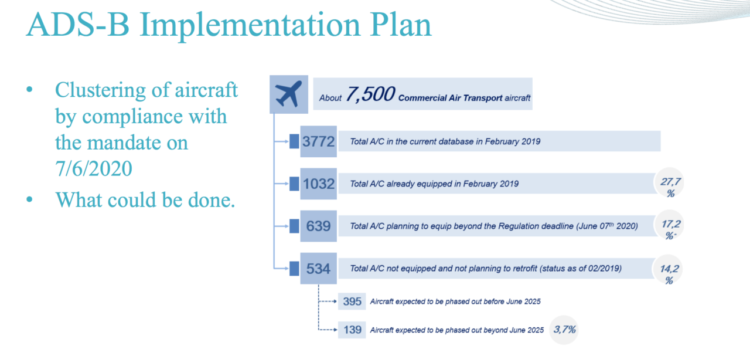
The ADS-B equipage status for commercial airliners in Europe. Photo: SESAR DM
European airlines have about 14 months until EASA’s June 7, 2020 ADS-B Out airspace mandate becomes effective. The Single European Sky ATM Research Agency Deployment Manager (SESAR DM) is in the process of finalizing a new ADS-B implementation plan that will allow for specialized exemptions and other provisions to help operators and ANSPs in the region meet the deadline.
According to the February 2019 European fleet data published by SESAR DM at the 2019 World ATM Congress in Madrid, there are an estimated 7,500 commercial air transport aircraft registered in Europe right now that are affected by the June 2020 ADS-B mandate. Of those, 3,772 are accounted for within EASA’s current database and out of that number, 1,032 have been equipped with mandate compliant ADS-B avionics.
That equipage status leaves SESAR DM with the task of establishing a plan that will allow some operators to exempt some of their aircraft from being required to be equipped with ADS-B by the deadline.

A snapshot of the draft of the short term ADS-B Implementation plan SESAR DM is working on right now. Photo: SESAR DM.
“Currently EASA is developing a proposal for potential exemptions based on the ADS-B Implementation Plan developed by SDM, which will be assessed by the European Commission and should be published soon,” said Jan Stibor, ADS-B program manager for SESAR DM.
Aircraft operators surveyed by SESAR DM submitted plans to the agency that included each individual aircraft by type and variant, MSN and the registration number and its current ADS-B capability — whether the aircraft is already equipped or by what date it will be equipped.
The plans also include the phase-out date of aircraft where known, the phase-in dates for new aircraft that will become part of the fleet in the future, and finally the individual cost of equipping each airframe, according to Stibor.
“These plans were consolidated in a SDM-internal database, which was subsequently used to elaborate the ADS-B Implementation Plan,” Stibor said. “Potential exemptions should be based on these plans.”
While neither SESAR DM nor the European Commission were able to confirm what an exemption in Europe would look like, both stated that an exemption policy is being developed. The world’s current example of an ADS-B Out exemption policy primarily geared toward airlines exists in the United States, providing a template that Europe could choose to follow. However, that policy still requires aircraft to be equipped, but not with all of the electronics required by the FAA’s 2020 rule.
Under the FAA’s Exemption 12555 policy, a one-time grant of exemption for aircraft from 14 CFR § 91.227 (Federal Aviation Regulations) exists for aircraft that are ADS-B Out equipped using qualifying GPS receivers when their performance falls below the requirement and backup surveillance is available.
The FAA established that exemption to address the performance characteristics associated with the three different variants of GPS receivers that are currently found in air transport category aircraft. Operators use these receivers to meet the ADS-B Out navigation integrity category requirements.
However, the difference in Europe at this point — pending further analysis of SESAR DM’s survey — seems to be that too many aircraft simply aren’t equipped at all.
Click here to check out the full version of this article as published in our new March 2019 edition of Avionics International.